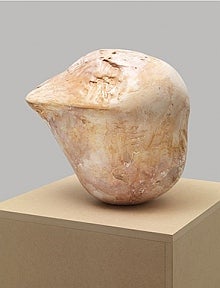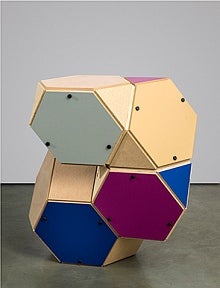 Gallery
One
Gallery
One
Robin
Peck
Crania.

Crania represents Robin Peck’s on-going series of sculptures of the same title, a project now comprised of over sixty individual pieces. Recalling in scale and shape one of nature’s most basic volumes—the cranium—these works evolve out of a highly personal dialogue with the mundane, yet provocative and sometimes incompatible stuff the artist engages with in his daily studio activity. A single sculpture, for example, might contain a complete collection of such disparate materials as sandstone, plaster, aluminum, burlap, quartz, Hydrocal, rubber, Plexiglas, then more plaster, before being finished with a luminous patina of shellac and carnauba wax. Often working on several sculptures at the same time, he joins, hammers, and rasps his materials into the right form, while other attempts are discarded or temporarily put aside for future consideration. The cerebral rigour of Peck’s process reflects his roots in minimalism and conceptual art, while his insistence on the value of making reminds us that the body is truly our fundamental means of knowledge and discovery. Each unique sculpture tells a story about the artist’s process and presence, and assumes a poignant vulnerability in our seemingly dystopic, post-industrial present.
Crania is co-curated by Doug Kirton and David MacWilliam, and presented in collaboration with the School of Art Gallery, University of Manitoba, Winnipeg; Southern Alberta Art Gallery, Lethbridge; University of Waterloo Art Gallery; and CANADA, New York City. The artist and co-curators wish to gratefully acknowledge the generous support of the Canada Council for the Arts.
 Gallery
Two
Gallery
Two
Laura
Marotta
New
Balance

Laura Marotta generates grid systems that disrupt standard square and rectangular structures. Using modular building blocks, she constructs and assembles forms that zigzag back and forth, shaping volumes that are tilting and asymmetrical. New Balance is a series of painted plywood tetrahedron sculptures that twist and turn and loop through space. These objects invite viewers to interact, to walk around and through compositions where negative space is as vital as the positive material form. While they reference public shelters, outdoor seating, or domestic objects like table tops, they also operate as architectural models; speculative plans and imaginative prompts that invite us to consider the potential of interacting—with each other and each form—on macro and miniature scales.
The exhibitions run from November 7 to December 21, 2019.
Robin Peck, Sculpture (Crania 70), 2016, Mixed media. Photo: Rachel Topham Photography.
Laura Marotta, Dazzling Blue, Spring 2014, 2014, Mixed media. Permanent Collection of the McMaster Museum of Art. Photo: Jon Evans Photography..